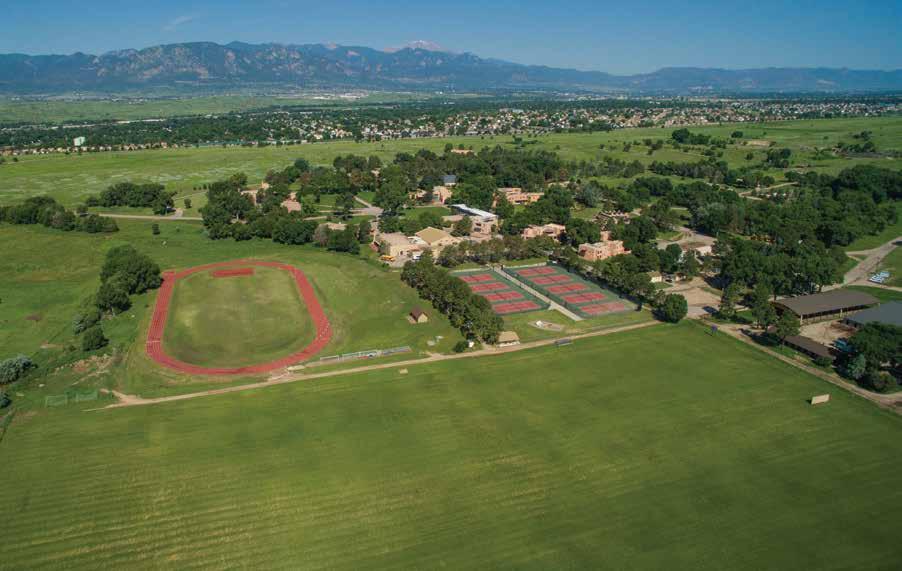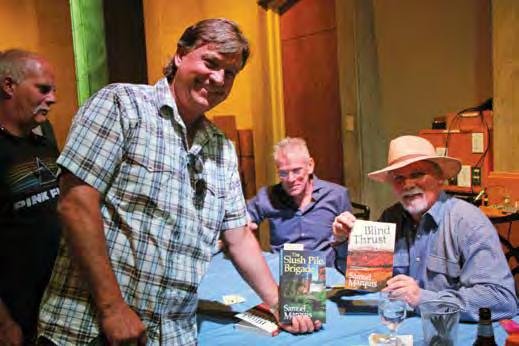
10 minute read
The Valley
Valley by Samuel Marquis ’79 The
n 1977, when I tumbled out of my parents’ Jeep onto the Fountain Valley School campus, I had no inkling that “the Valley” (as the Western preparatory school would soon become known to me) and its encompassing geographic area would one day have such a lasting impact on my life. True, I was a wide-eyed teenager with a penchant for troublemaking at the time; but all the same I never would have predicted that the school, its inspiring English teachers, and the surrounding prairie and rugged backdrop of Pikes Peak would serve as the framework for a career as a novelist. In fact, they provided critical fodder for a series of Coloradobased suspense novels—four suspense novels to be exact—each unique except for one recurring feature: all the books have included several of my real-life FVS cohorts as quirky fictionalized characters and/or Colorado Springs I
as the featured setting. But it goes deeper than that. You see, I began my career as a writer at Fountain Valley.
My first two novels, The Slush Pile Brigade and Blind Thrust (released in 2015), both were No. 1 Denver Post bestselling novels for fiction. In addition, Blind Thrust, an earthquake thriller, was an award-winning finalist in the fiction: thriller/ adventure category of the USA Best Book Awards. It was also named Foreword Reviews’ 2015 INDIEFAB Book of the Year award finalist (adult fiction: thriller and suspense). All of which means little except this: it might never have happened if not for Fountain Valley. FVS is the place where this rapscallion first developed an insatiable desire to—if not become a professional novelist—write authentic stories that come from the heart.
I wrote my first novel at Fountain Valley. In all honesty, it has to rank as one of the most stunning examples of juvenile incompetence in the annals of the literary world. I tried in vain to recreate the passion and authenticity of Nathaniel Hawthorne’s The May-Pole of Merry Mount by reimagining it as a modern tale. It was my senior project—working under pipe-smoking English faculty Chuck Emery ’38—and it was an absolute disaster. I scrawled out the novel on a yellow legal pad and, although I know that the manuscript is stashed somewhere in the basement of my house, I pray that it never again sees the light of day. But as bad as my attempt to update Hawthorne’s classic was, it marked the beginning of me becoming a fledgling novelist. In addition to Emery, my English teachers at FVS were Will Robinson, Jake Emery ’71 and Dick Henchey. Through all of them—but particularly Robinson and Jake Emery—I developed a passion for the English language and written word that has carried on for more than 35 years. Deep down, I probably always wanted to be a writer, but it was at FVS where I first developed the tools to find genuine inspiration in reading and writing. James Fenimore Cooper, Hawthorne, Melville, Hemingway, Fitzgerald, Faulkner, Tennessee Williams, Erskine Caldwell— these were the authors that I came to know and love at the Valley. Thanks to Robinson—an expert on Hemingway and the curmudgeonly author's legendary biographer, Carlos Baker—I came to especially treasure the spare yet emotionally charged prose of Papa Hemingway.
But if the Valley was where I first looked into a mirror and saw a rudimentary author, it is the friendships forged and the outlying southern Colorado physical setting that have made it repeatedly into my books. For example, The Slush Pile Brigade follows unknown author Nick Lassiter and his eccentric group of friends as they confront the world’s second best-selling author who stole his promising book, Blind Thrust, from the literary slush pile. Two of these amigos are based on my lifelong friends John Welch ’79 (as CU Professor of Anarchy Studies Frederick N. Welch, aka Squelch) and Peter Frautschi ’79 (as ascot-wearing millionaire M. Frautschi Claussen, aka Claggebart). The book also features fictionalized cameos by FVS board member Link Nicoll ’79 (who provided the cover photo for my author’s website as well as PR photos), Jake Emery (as a CIA black ops officer), Ben Paddock ’79, John Kohnstamm ’80 and Peter Sturgis ’78.
Blind Thrust and my third suspense novel, The Coalition, also feature FVS characters in fictionalized roles. I started the practice originally for not just my FVS buddies but for some of my grade school, college and adult friends as an inside joke. However, once I told people what I was doing, they were excited about being in the books and lobbied for expanded roles. During my Denver book launch last fall, I offered a chance for my guests/fans to be in future books. They were given three character choices: hero, villain or morally ambiguous. The sign-up resulted in the addition of still more FVS characters for The Coalition, including former FVS board president Greg Osborne ’81 as the president of the United States.
While carving out roles for my old FVS cohorts has been a light-hearted exercise, the settings and major characters for my novels have been influenced by my time spent at the Valley. Blind Thrust takes place largely in and around Colorado Springs and features energy tycoon Charles Prometheus Quantrill, who resides at The Broadmoor. The Coalition also spends time in the Colorado Springs area and features antagonist Benjamin Bradford Locke. He is the leader of the nation’s largest Christian religious-right political organization—Springs-based American Patriots—and a denizen of the Old North End. My World War II espionage thriller, Bodyguard of Deception (book one of a WWII trilogy), takes place at a fictional German prisoner of war camp (named Camp Pershing and modeled after Camp Trinidad, 1943-1946) plopped down on the prairie just a few miles east of FVS. Much of the action in all of these novels takes place on the streets of Colorado Springs, the prairies east of Colorado Springs (“prairie-trucking” anyone?), and atop Cheyenne Mountain and Pikes Peak.
As an example, here is a scene that takes place in Widefield in The Coalition:

As if they understood this in some ineffable way, Jennifer and Susan Locke were preoccupied with their thoughts as they pulled into the parking lot of______ in Widefield, a suburban enclave a few miles south of the Springs.
THE FIFTEENTH OF NOVEMBER seemed like it would be no different than any ordinary fall day— certainly not one that would go down as one of the bloodiest in Colorado history along with Sand Creek, the Ludlow Massacre, Columbine, and Aurora. The sky was razor-blue with wisps of white, the sun a subdued peach orb above the vast Great Plains to the east. The temperature was cool in a hearty autumn way, and a brisk wind stirred the fallen leaves, swirling them about. On the mountains to the west lay a fresh veneer of snow, like a shawl on the shoulders of a handsome elderly woman, Georgia O’Keeffe perhaps. The clear skies, chilly morning air, and spectacular backdrop of mountains seemed to reinforce the idea that this was truly God’s country, as many native Coloradans claimed, without reference to an actual deity, but to a natural physiographic majesty greater than humankind.
But today it was all just an illusion. I left out a key word because, well, I want you to read the book. But it goes without saying that the scene might never have been written if not for my teen years spent at the Valley. And I would wager that the following excerpt from Bodyguard of Deception might not have either:
With the mid-morning breeze at her back and her appaloosa tethered nearby, Katherine Templeton —owner of Left Hand Ranch and Colorado Springs’ opulent Broadmoor Hotel— stared out at the Great Plains from a rocky knob of Cretaceous limestone that skirted the western edge of her ranch. She was comfortable in her wide-brimmed western hat, embroidered leather riding skirt, and handtooled riding boots. Spread before her was a monstrous herd of bawling beef cattle, and she couldn’t help but picture what the land

before her had looked like back in the time of the buffalo—before the cattleman had wrested control of it from the lance-wielding Plains Indian a century earlier.
Imagining a colossal herd of the shaggy, cloven-hoofed beasts, she remembered back to her schoolgirl days when she had read the exciting Western tales of one of her favorite authors growing up, Karl May. The late nineteenth-century German novelist, prone to literary embellishment but nonetheless wildly popular in his day, had recounted the adventurous exploits of noble chief Winnetou, leader of the Mescalero Apaches, and his scouting partner, blood brother, and loyal friend Old Shatterhand. She took a deep breath and felt somehow whole, pure, connected as her mind drifted back a century to the world of the buffalo and wild red men who had hunted them in Karl May’s inspiring novels. And then, after a few minutes of quiet reverie, the past slowly metamorphosed once again to the tangible present and she was no longer overlooking a massive herd of buffalo, but a herd of bovines bearing her distinctive brand: LH with an arrow through it. She had named the ranch after the illustrious 1860s Arapaho Peace Chief Niwot, or Chief Left Hand as the southpaw’s name was translated into English. After giving her horse a little nugget of salt, she climbed back into the saddle and headed back to the ranch house. By the time she had combed him down and was climbing the freshly varnished wooden steps to her house, her top ranch hand, Jack Running Wolf, and three other cow hands rode up with a pair of mounted men with their hands tied to the saddle horns. She had a total of eleven men working for her as ranch hands,
four of whom were young Jewish men that she had helped escape from Paris when the SS was rounding up French Jews and deporting them to the NatzweilerStruthof concentration camp in the AlsaceLorraine area.
She squinted into the late May sunshine. ‘Looks like I owe you a dollar, Jack. You caught the rascals.’ The Comanche Indian nodded. ‘Yes, ma’am. They were heading for Wild Horse.’
The Valley. The name still resonates powerfully for me today: the people, the land, the authentic aura of the West. But more importantly, it provided me with the foundation to spin uniquely Western tales and the desire to become a professional novelist. Thank you to those who saw potential and offered early encouragement to a spirited young lad (translation: a hellion who quite possibly deserved to be straitjacketed). Because, in recalling that first manuscript I penned, I realize how you helped turn my youthful inclination towards mischief-making into a lifelong love for the written word. And ultimately, I know I wouldn’t be realizing my dream of being a novelist today without you. Samuel Marquis ’79 is a bestselling, awardwinning suspense author who works by day as vice president-hydrogeologist with CameronCole, an environmental consulting firm in Boulder. At FVS, he was the winner of the 1979 Varsity Club Award, given to the top athlete in the school (Marquis was an all-league soccer player, ice hockey team co-captain, and two-time all-state lacrosse player). He earned his B.S. degree in geology at Denison University and his M.S. degree in geology at Southern Methodist University. Marquis lives in Louisville, Colo., with his wife and three children and still plays competitive lacrosse, having competed in the 2014 U.S. World Lacrosse Games. His website is samuelmarquisbooks.com.











